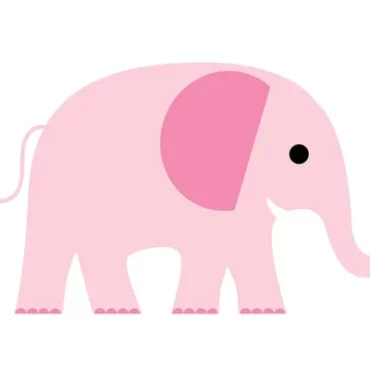

Pink Elephant Phenomenon
By Christine Coyle | April 7, 2022
“It’s precious real estate up there in your head, and there’s only so much thinking space our thoughts can occupy.”
Have you ever noticed what happens when you tell a child not to do something? They still do it; and may want to do it more because you brought attention to it. As a therapist, I know this; however, it hasn’t stopped me from telling (okay, let’s be real here…) yelling “no” at my toddler when he slams a controller against the television or stands on his rocking horse, all while flashing a sly smile in my direction. It’s referred to as the Pink Elephant effect. Once something is mentioned, it’s hard to get it out of your head and think about something else.
The same applies to our own brains and the thoughts we have each day. Allow me to pause here and explain an important difference between thoughts and intrusive thoughts:
We all have thoughts. They come and go quickly, kind of like watching your fruit, vegetables, cereal, and ice cream heading down the conveyor belt at the grocery store. Intrusive thoughts, however, are a different beast. They are the thoughts that come into our brains and get stuck and convince us that something is wrong.
When you experience an intrusive thought, the instinct is to try and push it out of your brain or ignore it because it’s unwanted and sometimes harmful. Can you do me a favor? Can you just take a minute and think about how this strategy works out for you? Go ahead, I’ll wait. What I can tell you is that the more I try to not think about something, the more it gets stuck. So, then what can we do to address these thoughts?
Karen Young with @Hey Sigmund says this about replacing thoughts:
“It’s precious real estate up there in your head, and there’s only so much thinking space our thoughts can occupy. That space can be taken up with negative thoughts or positive thoughts or both. The more negative thoughts there are, the less positive ones there will be. You’ve probably seen way too much evidence of this. The great news is that it also works the other way – the more positive thoughts there are, the less space there is for negative ones to set up camp. This isn’t a passive process though.”
What she means is that this takes effort and doesn’t happen overnight. Deciding what will take up space in your brain is a process that takes time. Even when you’ve developed this skill, negative thoughts may still pop up from time to time, but with more practice they will move through your mind more quickly.
It’s important to remember that sometimes intrusive thoughts that create feelings like fear or anxiety may be trying to tell us something.
Young states:
“We humans are designed to pay more attention to threats and negative information than to positive information. This is because for our survival, it’s more important that we’re aware of the things that could hurt us than the things that could make us happy.”
Mindfulness works differently, though. This strategy doesn’t attempt to change the thought but notices it, nonjudgmentally, and allows it to just be. Jon Kabat Zinn reminds us:
“Mindfulness means paying attention in a particular way: on purpose, in the present moment, and without judgment.” The last part of that definition, non-judgment, means letting go of the automatic judgments that arise in your mind with every experience you have.”
Before ending, I want to clarify – I am not saying “always be positive,” because we know the potential determinants of toxic positivity. What I am saying is notice your thoughts, decide if it is realistic and/or helpful and if not, decide to make a change about how to hold your thoughts. Trying different strategies can help determine which works best for you.
Sources:
https://www.mindful.org/everyday-mindfulness-with-jon-kabat-zinn/
Written by: Christine Coyle, LCSW-C, Owner/Therapist


